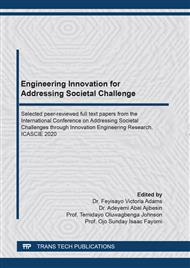[1]
Drinking Water: Understanding the Science and Policy Behind a Critical Resource. National Academies. www.water.nationalacademies. org (accessed October 14, 2019).
Google Scholar
[2]
Afzal, M., Rehman, K., Shabir, G. et al. (2019). Large-scale remediation of oil-contaminated water using floating treatment wetlands. Npj nature partner jourmal. https://doi.org/10.1038/s41545-018-0025-70025-7.
DOI: 10.1038/s41545-018-0025-7
Google Scholar
[3]
Caroline Barbosa Monteiro, Phelype Haron Oleinik, Thalita Fagundes Leal, Wiliam Correa Marques, João Luiz Nicolodi, Bruna de Carvalho Faria Lima Lopes. (2020). Integrated environmental vulnerability to oil spills in sensitive areas. Environmental pollution journal. https://doi.org/ 10.1016/j.envpol. 2020.115238.
DOI: 10.1016/j.envpol.2020.115238
Google Scholar
[4]
Shweta Wadhawan, Ayushi Jain, Jasamrit Nayyar, Surinder Kumar Mehta. (2020) Role of nanomaterials as adsorbents in heavy metal ion removal from wastewater: A review https://doi.org/10.1016/j.jwpe.2019.101038.
DOI: 10.1016/j.jwpe.2019.101038
Google Scholar
[5]
Hassimi Abu Hasan, Mohd Hafizuddin Muhammad, Nur 'Izzati Ismail (2019). A review of biological drinking water treatment technologies for contaminants removal from polluted water resources. https://doi.org/10.1016/j.jwpe.2019.101035.
DOI: 10.1016/j.jwpe.2019.101035
Google Scholar
[6]
Feyisayo V Adams, Faustine Hategekimana, O'donnell P. Sylvester (2017). Crude Oil Contaminated Water Treatment: Development of Water Filter from Locally Sourced Materials. https://doi.org/10.1016/j.promfg.2016.12.039.
DOI: 10.1016/j.promfg.2016.12.039
Google Scholar
[7]
Pranoto, Inayati, Fathoni Firmansyah. (2018) Effectiveness Study of Drinking Water Treatment Using Clays/Andisol Adsorbent in Lariat Heavy Metal Cadmium (Cd) and Bacterial Pathogens. 12th joint conference of Chemistry.
DOI: 10.1088/1757-899x/349/1/012047
Google Scholar
[8]
Sulistyarini A. (2012) Identification, activation, and Characterization of Soil Volcanic Mount Arjuna as Penjerap Metal Copper (Cu). Fakultas Matematika dan Ilmu Pengetahuan Alam Universitas Sebelas Maret.
DOI: 10.52574/syiahkualauniversitypress.354
Google Scholar
[9]
Van-Halem D. (2006) Ceramic Silver Impregnated Pot Filters for Household Drinking Water Treatment in Developing Countries. Thesis. Sanitary Engineering Section, Department of Water Management, Faculty of Civil Engineering, Delft University of Technology.
DOI: 10.2166/ws.2007.142
Google Scholar
[10]
A.A. Daifullah, B.S. Girgis, H.M. Gad. (2003). Utilization of Agro-residues (rise husk) in small wastewater treatment plants Material Lett., 57 (2003), pp.1723-1731. https://doi.org/10.1016/S0167-577X(02)01058-3.
DOI: 10.1016/s0167-577x(02)01058-3
Google Scholar
[11]
Connors S, Lanza R, Sirocki A (2013). Removal of Ibuprofen from Drinking Water Using Adsorption. https://digitalcommons.wpi.edu/cgi/viewcontent.cgi?article=3715&context=mqp-all.
Google Scholar
[12]
Pranoto, Sajidan, A Suprapto (2017). The Characteristic and Activation of Mixed Andisol Soil/Bayat Clays/Rice Husk Ash as Adsorbent of Heavy Metal Chromium (Cr).
DOI: 10.1088/1757-899x/176/1/012022
Google Scholar
[13]
Zwain, H.; Vakili, M.; Dahlan, I. (2014) Waste Material Adsorbents for Zinc Removal from Wastewater: A Comprehensive Review. International Journal of Chemical Engineering. https://doi.org/10.1155/2014/347912.
DOI: 10.1155/2014/347912
Google Scholar
[14]
Sulastri S, Kristianingrum S., (2007). Proceedings of the National Seminar of Chemistry and Chemical Education. ISBN: 978-979-98063-1-4.
Google Scholar
[15]
Sulistyarini, Ari. (2012). Fakultas Matematika dan Ilmu Pengetahuan Alam Universitas Sebelas Maret.
DOI: 10.52574/syiahkualauniversitypress.354
Google Scholar
[16]
Chaukura, N., Chiworeso, R., Gwenzi, W., Motsa, M. M., Munzeiwa, W., Moyo, W., Chikurunhe, I., & Nkambule, T. T. I. (2020). A new generation low-cost biochar-clay composite biscuit, ceramic filter for point-of-use water treatment. Applied Clay Science, 185, 105409. https://doi.org/10.1016/j.clay.2019.105409.
DOI: 10.1016/j.clay.2019.105409
Google Scholar
[17]
Huang, J., Huang, G., An, C., He, Y., Yao, Y., Zhang, P., & Shen, J. (2018). Performance of ceramic disk filter coated with nano ZnO for removing Escherichia coli from water in small rural and remote communities of developing regions. Environmental Pollution, 238, 52–62. https://doi.org/10.1016/j.envpol.2018.03.008.
DOI: 10.1016/j.envpol.2018.03.008
Google Scholar
[18]
Kamali, M., Suhas, D. P., Costa, M. E., Capela, I., & Aminabhavi, T. M. (2019). Sustainability considerations in membrane-based technologies for industrial effluents treatment. Chemical Engineering Journal, 368, 474–494. https://doi.org/10.1016/j.cej.2019.02.075.
DOI: 10.1016/j.cej.2019.02.075
Google Scholar
[19]
Mauter, M. S., Zucker, I., Perreault, F., Werber, J. R., Kim, J. H., & Elimelech, M. (2018). The role of nanotechnology in tackling global water challenges. In Nature Sustainability (Vol. 1, Issue 4, p.166–175). Nature Publishing Group. https://doi.org/10.1038/s41893-018-0046-.
DOI: 10.1038/s41893-018-0046-8
Google Scholar
[20]
Dele-Afolabi, T. T., Hanim, M. A. A., Norkhairunnisa, M., Sobri, S., & Calin, R. (2017). Research trend in the development of macroporous ceramic components by pore forming additives from natural organic matters: A short review. In Ceramics International (Vol. 43, Issue 2, p.1633–1649). Elsevier Ltd. https://doi.org/10.1016/j.ceramint.2016.10.177.
DOI: 10.1016/j.ceramint.2016.10.177
Google Scholar
[21]
Ewais, E. M. M., & Bayoumi, I. M. I. (2018). Fabrication of MgO-CaZrO3 refractory composites from Egyptian dolomite as a clinker to rotary cement kiln lining. Ceramics International, 44(8), 9236–9246. https://doi.org/10.1016/j.ceramint.2018.02.134.
DOI: 10.1016/j.ceramint.2018.02.134
Google Scholar
[22]
Holdich, R., Schou, K., Dragosavac, M., Kellet, S., & Bandulasena, H. (2018). A comparison of azimuthal and axial oscillation microfiltration using surface and matrix types of microfilters with a cake-slurry shear plane exhibiting non-Newtonian behaviour. Journal of Membrane Science, 550, 357–364. https://doi.org/10.1016/j.memsci.2017.12.079.
DOI: 10.1016/j.memsci.2017.12.079
Google Scholar
[23]
Knapek, M., Kušnír, J., Húlan, T., Minárik, P., Csáki, Š., Lukáč, F., Dobroň, P., & Chmelík, F. (2020). Mechanical properties of illite-based ceramics with controlled porosity studied by modern in situ techniques. Journal of the American Ceramic Society, 103(4), 2780–2790. https://doi.org/10.1111/jace.16940.
DOI: 10.1111/jace.16940
Google Scholar
[24]
NSDWQ, 2007. Nigerian Standard for Drinking Water Quality. Nigerian Industrial Standard NIS 554, Standard Organization of Nigeria, p.30.
Google Scholar
[25]
World Health Organization. (2017). WATER QUALITY AND HEALTH – REVIEW OF TURBIDITY: Information for regulators and water suppliers. Who/Fwc/Wsh/17.01, 10. https: //www.who.int/water_sanitation_health/publications/turbidity-information-200217. pdf%0A http:// www.who.int/water_sanitation_health/publications/turbidity-information-200217.pdf.
DOI: 10.4103/2224-3151.213787
Google Scholar


